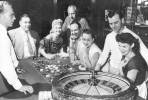Polaroid Fotobar at the Linq updates the classic Polaroid experience
Pose. Point. Smile. Snap.
Though the basics have stayed the same, the art of taking a photo ready to share with friends and family has evolved over the decades and become more popular.
“At no other time in history have people taken so many photos,” says Warren Struhl, owner of Polaroid Fotobar. “About 880 billion photos will be taken this year.”
Before smartphones provided the instant gratification of taking and showing photos, the fastest way to snap a memory was the Polaroid camera.
The Polaroid Fotobar, which opened inside The Linq in March, was designed to make it just as easy for smartphone users to have copies of their pictures.
About four years ago, Warren Struhl started asking friends and family to show him their favorite pictures.
“I asked them if they had those photos on their desk or on their walls at home,” he says. “I had a hunch how they would answer.”
About 95 percent didn’t have a hard copy because there wasn’t an easy way to print them out.
“People wanted an easy and fun way to do it,” he adds.
With that in mind, Struhl founded the Polaroid Fotobar and opened the first store in Florida in 2012.
“We knew immediately the notion of people being able to liberate their photos was a success,” he says. “We started opening more locations.”
He adds people are also drawn to the Polaroid name, which was created by Edwin Land in 1937. Struhl has a licensing agreement that allows him to use the brand name.
“Polaroid is one of the top recognized brands in the world,” he says.
When looking to expand, Struhl thought Las Vegas would be a great place to host the flagship location.
“We were looking around the country and figured per capita more pictures were taken in Las Vegas than anywhere else,” he says.
Visitors entering the Polaroid Fotobar always ask what the shop does.
“People want to know if we sell cameras,” says general manager Rachael Shepherd. “They are curious to know what we’re about. I tell them we can take any photo and make it into something special.”
People upload photos from Facebook or their phones and print them out onto Polaroid format, whether it’s a 9-by-11 print or 24-by-30.
“It’s all done in a matter of minutes,” she says.
Shepherd says people can even bring in older photos and have them sent away to be digitally restored.
She adds people can also buy refurbished Polaroid cameras anywhere from $100 to $300 depending on the type.
“We sell 15 to 20 cameras every two to three weeks,” she says. “People love them. They think they’re are perfect for parties or events.”
Unlike the other four locations in Florida, Struhl says the company decided to make the Las Vegas location different by adding The Polaroid Museum, which has a $5 admission price. Most of the artifacts are on loan from the Polaroid Historical Collection at the MIT Museum.
“People are really intrigued by the history of the Polaroid Corporation,” Struhl says.
Dov Quint, the vice president of business development for Polaroid Fotobar, says the museum worked closely with Mary-Kay Lombino, author of “The Polaroid Years: Instant Photography and Experimentation,” who curated the exhibit.
Quint says many of the works are on lease for about a year.
“There certainly isn’t a lack of great artwork we could choose from,” Quint says.
What can be found in the museum?
A clunky, brown leather chair that once belonged to Edwin Land, the creator of the Polaroid camera, sits in the museum’s corner. Above it hangs his photo with a quote: “Don’t do anything that someone else can do. Don’t undertake a project unless it is manifestly important and nearly impossible.”
A mantra that inspired decades of creations from the 1948 Model 95 to the 2010 OneStep — each device is highlighted on the museum’s timeline.
“I bet you can’t find these on eBay for $35 anymore,” Shepherd says as she points to an advertisement of the OneStep Polaroid from 1977.
In between the history, other decades are represented by Polaroid cameras such as a Sun 640 and an SX-70.
“It’s funny to have customers come in here and say they remember having this model,” Shepherd says. “Everyone has a story.”
One main feature is one of Land’s largest — the world’s largest in fact — Polaroid cameras with its 20-by-24 prints developed in 1976.
“The story goes: On a Friday morning, Edwin Land walked up to his engineering department and said he wanted something that could show off his larger format prints for a meeting he had,” Quint says. “They spent the entire weekend cooking this up, working through the night. Seventy-two hours later, they had put this together.”
Quint says that camera was a raw concept, from which the engineers were able to construct others.
For a pretty penny — about $5,000 — people can have portraits made by a 20-by-24 camera at The Polaroid Museum.
“We’ve done a couple shots here,” Quint says.
Though Land created and re-created versions of the Polaroid camera, the tour also features artists such as Lucas Michael, Maurizio Galimberti, Marc Serota and Maripol who found new ways to use the device. Many of their works are on display and feature anything from the straightforward Polaroid shots of celebrities at The Academy Awards to Polaroid mosaics.
“The overriding theme is celebrity,” Quint says.
Throughout the museum — something Quint foresees as a constant theme no matter if the exhibit changes out its artists — are tributes to Andy Warhol and his usage with the Polaroid.
There is also an “Instant Storytellers” display, which features a mobile photography exhibit of photos sent through Instagram.
“Today’s photos done on smartphones or through Instagram have the same characteristics of Polaroid,” Quint says. “It has many of the same tenets.”
Quint says the exhibit ties the past and the present together.
“The Polaroid brand was all about instant sharing and social collaboration,” Quint says.
In recent years, that sentiment has been recaptured through social media ventures such as Instagram.
While remembering its history, Quint says it’s important to acknowledge the impact the company has had on culture.
In doing so, the museum has incorporated video and print advertisements into the exhibit.
It wasn’t just society as a whole it inspired.
“Edwin Land inspired Steve Jobs,” Shepherd says.
Struhl views Polaroid as the Apple of its time.
“It was innovative with its technology,” he adds. “Edwin Land and Steve Jobs were kindred spirits.”
He adds that even the company’s marketing and branding affected culture just as Apple did.
Although the exhibit touches on the historical value of Polaroid, Quint says it has another hidden power.
“It inspires people to become photographers,” he says. “You don’t need to spend thousands of dollars on SLRs (single-lens reflex cameras). You can do this all with your smartphone. You have the medium to be creative in. Everyone has access to their inner photographer, in their pocket.”
Contact reporter Michael Lyle at mlyle@reviewjournal.com or 702-387-5201. Find him on Twitter: @mjlyle





































